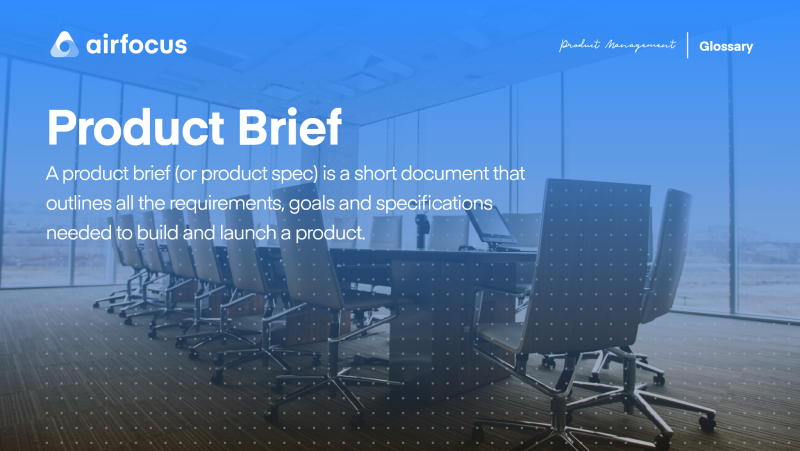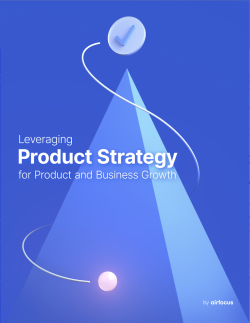Product Brief
What is a Product Brief?
Definition of a Product Brief
A product brief (or product spec) is a short document that outlines all the requirements, goals, and specifications needed to build and launch a product.
The product brief acts as a single-source of truth for all departments involved in a project, from UX design to software development, marketing, and sales.
Ideally, the document should be the result of a collaborative effort, to make sure that all aspects of product development have been accurately sketched out.
Why is a product brief important?
A product brief provides vital context for the build and unifies the efforts of all departments involved in product development.
In doing so, it helps product teams push in the same direction and stay on schedule.
A well-crafted product brief eliminates presumptions and avoids misunderstandings, offering clear strategic guidelines. A product brief is also important because it creates a fruitful environment for product teams to collaborate and brainstorm new ideas.
Let’s say you’re building a new platform designed to connect event managers with sponsors.
A product brief can help developers and marketing teams start a conversation around the importance of certain features according to market relevance. This way, the outcome is guaranteed to be high-quality and have a certain degree of novelty essential to all successful user-centric products.
What should a product brief include?
For a product brief to achieve its goal, it needs to answer several key questions that are of interest to all product development teams.
To begin with, the document has to include a short summary of the product (the ‘what’) and the motivation behind building it (the ‘why’).
Since successful products tackle real consumer needs, the brief has to underline the problem the product is trying to solve and give further insight into how it plans to do so.
A market analysis (SWOT predictions, use cases, metrics) is also mandatory, alongside an overview of the competition. The reason for this is simple: the more real-market data your team has, the better their solutions will be.
Of course, no product brief would be complete without a schedule for implementation and a post-production plan to measure the results, too.
Ideally, the product brief should be the result of a collaborative effort, to make sure that all aspects of product development have been accurately sketched out. The document will then be used the provide consistency and quality as the product development progresses.
When should you create a product brief?
You should create a product brief during the initial stages of product development. This document will help define the path you take from ideation to release. However, simply creating a product brief on day one and trying to stick to it weeks later won’t help the process.
The product brief is essential in the early stages, but it can become redundant as requirements change. Locking in the brief with early-stage information and requirements will remove any sense of flexibility in the process.
Instead, the product brief should be a living document that continues to evolve as research and dependencies pop up. This may mean that the product brief's final iteration is drastically different from the original, but the product addresses all the user needs you’ve identified during market research.
5 reasons why a product brief is important (+ examples)
A product brief provides vital context for the build and unifies the efforts of all departments involved in development. In doing so, it helps product teams push in the same direction and stay on schedule.
A well-crafted product brief can:
Eliminate presumptions and avoid misunderstandings by offering clear strategic guidelines.
Create an inspiring, effective environment for product teams to collaborate and brainstorm new ideas.
Offer clarity by compiling the most crucial information into one, simple-to-understand document.
Reduce errors by creating a universal understanding of the product vision.
Increase efficiency by removing the risk of scope creep.
5 tips for writing a product brief
Now that you know what a product brief is and why it’s important, let’s look at airfocus’s top tips for writing a product brief:
1. Run market analysis
Market analysis — such as SWOT, use cases, and metrics — is a key step when writing a product brief. The reason for this is simple: the more real-market data your team has, the better their solutions will be.
2. Identify your user’s problem(s) first
Before you can write a product brief, you need to identify and understand the problems your customers want to resolve. You should figure out the needs of your target audience, how you can address those needs, and the overarching goals this product should achieve.
3. Give the product plenty of context
The product brief should provide plenty of context alongside product requirements. This includes competitive analysis, a well-defined target audience, and an estimated cost of development.
4. Create a timeline
A timeline can help visualize the product scope when interacting with stakeholders. Of course, it’s tough to create a highly accurate time frame in the early stages, but a rough outline helps set expectations for those with an interest in the product outside of the development team.
5. Don’t worry about the name!
What you’ll name your product should be the last thing your team is thinking about at this early stage. Sure, you can give it a catchy internal project name, but don’t waste too much time on finding the ‘right’ one.
Product brief template
Product briefs should be highly specific to the project you’re going to work on. This means there is no one-size-fits-all template for product briefs.
That said, many product briefs will follow a similar format and teams can get started faster by using a template and customizing their brief from there. Every product brief template will include:
Product purpose
Opportunity
Target audience
Competitors
Success metrics
Risks
Pricing options
Timeline of development
Further notes/comments
Next steps after creating a product brief
The work doesn’t stop once you write the product brief. Here’s what you should do with your brief during various stages of development.
Get feedback on your brief
Once your product brief feels complete, it’s helpful to get another perspective. Sharing the brief with cross-functional teams and stakeholders ensures that anything you’ve missed can be picked up before it becomes a problem. There are also a lot of variables in product development, so extra eyes on the brief can help you plan for any unexpected turns.
Make changes based on feedback
There’s no point asking for feedback if you’re not going to act upon it. Embrace the new perspectives and incorporate them into your product brief. Remember, as a living document, the product brief will constantly change, so there’s no reason to worry about changes early in the process.
Start development based on the information in your product brief
This may seem obvious, but the product brief should be the starting point for your development efforts. While the document isn’t a technical specification, it should contain enough information and context to get you started.
Update the brief regularly
You should revisit your product brief regularly as the product evolves throughout development. If the product brief is left as a static document, you risk teams falling out of alignment with the product goals and customer needs. Whenever there is a change to the product, return to your brief and make the appropriate updates.
Use the product brief to secure buy-in and ensure alignment
You should use the product brief to align everyone involved in the project with the product goals. Even as the product evolves, we can use the product brief to maintain buy-in from stakeholders and keep customer needs at the forefront of the development team’s minds.
Product brief template
Product purpose
Here you should describe the primary goal of your product and how it solves a problem or meets a need.
Opportunity
This refers to the market opportunity or the identified gap in the market that the product aims to address.
Target audience
This refers to the group of users or customers the product is designed to be used by.
Competitors
This lists the existing products in the market which represent direct competition to the planned development and may also include their strengths, weaknesses, and key differentiators.
Success metrics
These are the Key Performance Indicators (KPIs) that will be used to measure the product's success once launched.
Risks
Every product faces potential risks and challenges, this is the place in the product brief to list them.
Pricing options
Depending on the product, the different pricing models will be detailed here, including any subscriptions or one-time purchase options.
Timeline of development
Key developmental milestones should be listed here and then used to track progress as development goes on.
Further notes/comments
This optional section can be used to add any other information deemed essential to the product brief, like tentpole features, user feedback, or important design considerations.
Product brief template example
Let's create one to better explain how product briefs are put together. Here’s a product brief template example for a new stock control SaaS product, “StockPal.”
Product purpose: StockPal is a cloud-based inventory management software designed to address inefficient inventory management. StockPal solves common stock control problems by providing a centralized platform for inventory management.
Opportunity: Online and offline stores often struggle to keep track of their inventory levels, leading to running out of stock, carrying too much stock, and avoidable lost sales.
Target audience: Small to medium-sized businesses, Direct-to-Consumer brands, and retailers.
Competitors: Inventory by Zoho, QuickBooks Commerce
Success metrics: Improved stock turnover rates, more accurate stock counts, reduced out-of-stock and overstocking issues
Risks: Difficulty creating differentiation vs. competing platforms, lack of adoption from large retailers
Pricing options: SaaS subscription, lifetime license
Timeline of development: 6 months of R&D, 3 months of beta testing, 1 month GA launch window
Further notes/comments: StockPal must launch with third-party integrations with Shopify and WooCommerce
How you can use airfocus' AI assist to help you write better product briefs
AI Assist taps into the power of generative AI to supercharge any product manager’s workflows.
Lost for words when writing product briefs? Just give AI Assist a simple one-line prompt and watch as it generates an accurate, data-driven product brief that identifies customer pain points, defines the target audience, and helps orchestrate competitive analysis.
The best part? It does it all right within airfocus, saving you time and streamlining your day.
4 AI assist prompt examples for writing product briefs
If you’re looking for AI assistance with your product briefs, try these prompts with airfocus AI assist. Remember that the more info you can provide, the more accurate the results will be:
“Write a product brief for a [type of product] SaaS application called [name]”
“Write a product brief for a [type of product] SaaS application called [name], which includes the key feature [feature description]”
“Write a product brief for a [type of product] SaaS application called [name], including the product purpose, opportunity, target audience, competitors, success metrics, risks, pricing options, and development timelines.”
“Write a detailed product brief section called [section name (e.g. target audience, risks, etc.)] about a [type of product] SaaS application called [name]”

General FAQ

Glossary categories
Create effective product strategy

Experience the new way of doing product management








